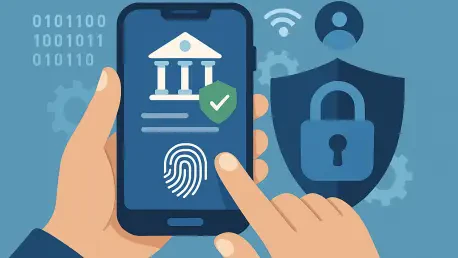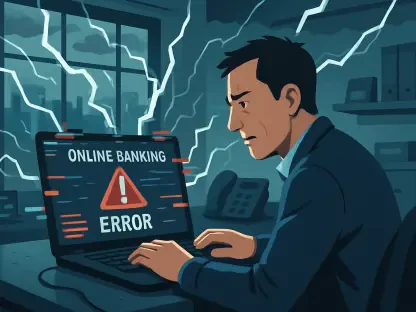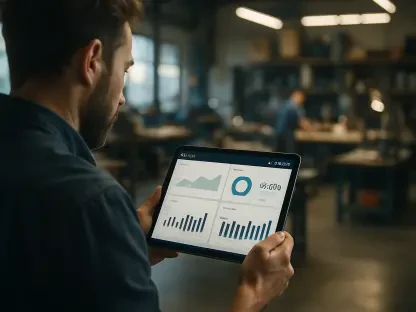In an era where smartphones have become the primary tool for managing finances, mobile banking offers unparalleled convenience for millions of Americans who check balances, transfer funds, and pay bills with just a few taps. However, this ease of access also makes it a prime target for cybercriminals looking to exploit vulnerabilities in user behavior and technology. Fraud targeting mobile banking apps is on the rise, with sophisticated scams designed to steal sensitive data. The silver lining is that with the right precautions, mobile banking can be even safer than traditional methods like using a debit card at a store. Banks invest heavily in advanced security measures, but the responsibility also falls on users to adopt smart habits. This article dives into expert-recommended strategies to protect money and personal information, ensuring that the benefits of mobile banking are not overshadowed by preventable risks. By following practical steps, users can confidently navigate the digital financial landscape.
1. Download Only Trusted and Verified Apps
Securing a mobile banking account begins with ensuring that the app being used is legitimate and safe. Always start by visiting the bank’s official website and using the provided links to download the app from trusted platforms like the App Store or Google Play. It’s critical to verify the developer’s name and read user reviews to confirm authenticity before installation. Cybercriminals often create fake apps that mimic the real ones, tricking users into entering login credentials that are then stolen. Avoiding downloads from unofficial forums, third-party websites, or links shared via social media ads is a must. Such sources are often riddled with malware or fraudulent apps designed to compromise security. Taking a moment to double-check the source can prevent falling victim to these deceptive tactics and keep sensitive data out of the wrong hands. Comparing banks with highly rated mobile apps can also guide users toward institutions prioritizing secure and user-friendly digital experiences.
Staying vigilant about app sources is only the first layer of defense against mobile banking fraud. Even legitimate apps can become targets if downloaded from unverified links or if users are misled by cleverly disguised phishing attempts. The FBI has warned about app-based banking Trojans—malware hidden in seemingly unrelated apps that activate when a banking app is opened, mimicking login screens to steal credentials. This underscores the importance of sticking to official channels for downloads. Beyond the initial download, keeping the app updated ensures that security patches and enhancements are applied, closing potential loopholes exploited by hackers. Users should also be cautious of unsolicited messages or emails prompting app installations, as these are often gateways to fraud. By maintaining a strict policy of using only verified sources, the risk of installing malicious software is significantly reduced, forming a solid foundation for safe mobile banking practices.
2. Enable Multi-Factor Authentication for Extra Protection
Adding an additional layer of security through multi-factor authentication (MFA) is a powerful way to safeguard mobile banking accounts. This method requires at least two forms of identity verification before granting access—typically a password combined with a unique code sent to a phone or email. Even if a password is compromised, the secondary verification step acts as a barrier, preventing unauthorized access by hackers. Most banks offer this feature within their app settings, and enabling it is often a straightforward process. MFA significantly reduces the likelihood of account breaches, as it ensures that a stolen password alone isn’t enough to gain entry. Users are encouraged to activate this feature immediately upon setting up their mobile banking app to fortify their defenses against evolving cyber threats. Learning more about how MFA works can provide clarity on its benefits and implementation across different platforms.
The importance of multi-factor authentication cannot be overstated, especially as cybercriminals employ increasingly sophisticated methods to steal login information. Phishing attacks and malware can trick users into revealing passwords, but MFA adds a critical checkpoint that such tactics cannot easily bypass. For instance, a one-time code sent via text or generated by an authenticator app ensures that only the account holder can proceed with login. Banks continuously update their security protocols to integrate MFA seamlessly, making it a user-friendly yet robust tool. It’s also worth noting that while MFA enhances security, it’s not foolproof if the secondary device or email is compromised—highlighting the need to secure all access points. Regularly reviewing account settings to confirm that MFA remains active is a prudent habit, as updates or app reinstalls might disable it. This proactive step ensures continuous protection against unauthorized access attempts in the dynamic landscape of digital banking.
3. Create Strong and Unique Passwords for Every Account
Crafting strong, unique passwords is a fundamental step in securing mobile banking accounts from unauthorized access. A robust password should include a mix of uppercase and lowercase letters, numbers, and special characters, making it difficult for hackers to guess or crack through automated tools. Reusing passwords across different accounts is a risky practice, as a breach in one platform could compromise others. Storing passwords in browsers should be avoided due to vulnerabilities; instead, a reputable password manager can safely store and generate complex passwords. This approach not only enhances security but also simplifies managing multiple credentials. Banks often provide guidelines for creating secure passwords during account setup, and adhering to these recommendations is essential. By prioritizing password strength, users build a critical defense against cyber threats targeting personal and financial information.
Beyond creating strong passwords, maintaining their uniqueness across platforms is equally vital for mobile banking security. Cybercriminals often exploit password reuse by using credentials stolen from one site to attempt logins on others, including banking apps. A single breach can thus cascade into broader financial risks if passwords are duplicated. Password managers offer a practical solution by generating and storing unique passwords for each account, eliminating the need to remember them manually. Additionally, users should periodically update passwords, especially after a security alert or data breach involving other services. Banks may also prompt for password changes as part of their security protocols, and complying promptly adds another layer of protection. Avoiding common phrases, birthdays, or easily guessable information in passwords further minimizes risks. This disciplined approach to password management ensures that even if one account is targeted, the impact remains isolated, preserving overall financial security.
4. Avoid Public Wi-Fi When Accessing Banking Apps
Using public Wi-Fi networks for mobile banking poses significant risks due to their vulnerability to hacking and data interception. These free networks, often available in cafes, airports, or libraries, lack the robust security measures of private connections, making it easier for cybercriminals to monitor activity and steal sensitive information like login credentials. When accessing banking apps, relying on mobile data or a trusted, secure home network is the safer choice. If public Wi-Fi must be used in an emergency, employing a virtual private network (VPN) can encrypt data transmission, adding a layer of protection. However, the best practice remains avoiding such networks altogether for financial transactions. This precaution prevents potential breaches that could expose personal and financial details to unauthorized parties, ensuring that banking activities remain confidential and secure.
The risks associated with public Wi-Fi extend beyond simple data theft, as hackers can deploy sophisticated tools to intercept unencrypted communications. Man-in-the-middle attacks, where a cybercriminal positions themselves between the user and the network, are a common threat on public networks, allowing attackers to capture sensitive data in real time. Mobile banking apps often handle critical transactions, and any compromise could lead to significant financial loss. Sticking to mobile data plans, even if they incur additional costs, offers a more secure alternative, as these connections are typically encrypted by default. For those who travel frequently or work remotely, investing in a personal hotspot device can provide a controlled, secure network for banking needs. Educating oneself about the dangers of unsecured connections reinforces the importance of this precaution, ensuring that convenience does not come at the expense of security in the digital banking realm.
5. Recognize and Avoid Phishing and Smishing Scams
Staying alert to phishing and smishing scams is crucial for protecting mobile banking accounts from fraudulent schemes. Phishing involves deceptive emails that appear to come from legitimate sources, such as a bank, urging users to reveal personal information or click on malicious links that install malware. Smishing operates similarly but uses text messages to trick recipients into sharing sensitive data or downloading harmful software. These tactics often mimic official communications, using urgent language to create panic and prompt immediate action. Scrutinizing messages for unusual phrasing, unfamiliar sender details, or suspicious links before responding is essential. Banks typically do not request personal information via email or text, so any such request should raise red flags. Resources on safeguarding accounts from hackers offer detailed guidance on identifying and avoiding these traps, empowering users to stay one step ahead of scammers.
Vigilance against phishing and smishing requires ongoing awareness, as cybercriminals continuously refine their methods to appear more convincing. For instance, fake messages might reference specific account details or recent transactions to gain trust, making them harder to spot. Users should avoid clicking on any links or downloading attachments from unsolicited communications, as these often lead to credential theft or malware installation. Verifying the authenticity of a message by directly contacting the bank through official channels—rather than replying to the suspicious communication—can prevent falling into a trap. Additionally, enabling spam filters on email and messaging apps can reduce exposure to fraudulent attempts. Staying informed about the latest scam trends through bank notifications or trusted security blogs adds another layer of defense. By cultivating a skeptical mindset toward unexpected requests for information, users can significantly lower the risk of compromise in their mobile banking activities.
6. Activate Account Notifications for Real-Time Monitoring
Setting up account notifications is a proactive measure to detect and respond to potential fraud in mobile banking accounts swiftly. Most banks offer customizable alerts via email, text, or their app, notifying users of transactions, withdrawals, or login attempts in real time. This immediate feedback allows for quick identification of unauthorized activity, enabling prompt action to secure the account. Time is critical in fraud cases, as Regulation E limits liability to $50 if unauthorized transactions are reported within two business days. Configuring alerts to match specific needs—such as notifications for large transactions or international payments—ensures that no unusual activity goes unnoticed. This feature transforms a mobile device into a constant monitor of financial security, providing peace of mind and a rapid response mechanism against potential threats. Activating these alerts should be a priority for anyone using mobile banking services.
The effectiveness of account notifications lies in their ability to bridge the gap between an incident and a user’s awareness, minimizing damage from fraudulent activities. For example, a notification about a transaction that wasn’t initiated by the account holder can trigger an immediate call to the bank to freeze the account or dispute the charge. Banks often allow users to set thresholds for alerts, ensuring that only significant or suspicious activities prompt a notification, avoiding alert fatigue from routine transactions. Regularly reviewing and updating alert preferences keeps them relevant to changing financial habits or travel plans that might affect transaction patterns. Beyond fraud detection, these alerts can also help in managing budgets by tracking spending in real time. This dual benefit makes notifications an indispensable tool in the mobile banking toolkit, reinforcing security while enhancing overall financial oversight in a fast-paced digital environment.
Building a Safer Mobile Banking Future
Reflecting on past efforts to combat mobile banking fraud, it becomes evident that user vigilance plays a pivotal role in maintaining account security. Banks have invested billions in cybersecurity, employing encryption and protective measures like FDIC insurance to cover losses, yet breaches still occur when users neglect basic safeguards. The journey shows that while technology provides robust defenses, human error often opens doors to cybercriminals. Moving forward, the focus should shift to integrating security habits into daily routines, such as regularly updating apps to patch vulnerabilities and choosing financial institutions with a proven track record of strong encryption. Exploring additional resources on the advantages of mobile banking and strategies against online fraud can further empower users. As threats evolve, staying informed about emerging risks and adopting advanced tools will be essential to ensure that digital banking remains a safe and convenient option for managing finances.









